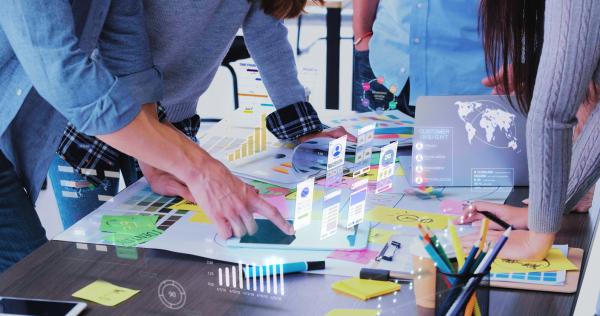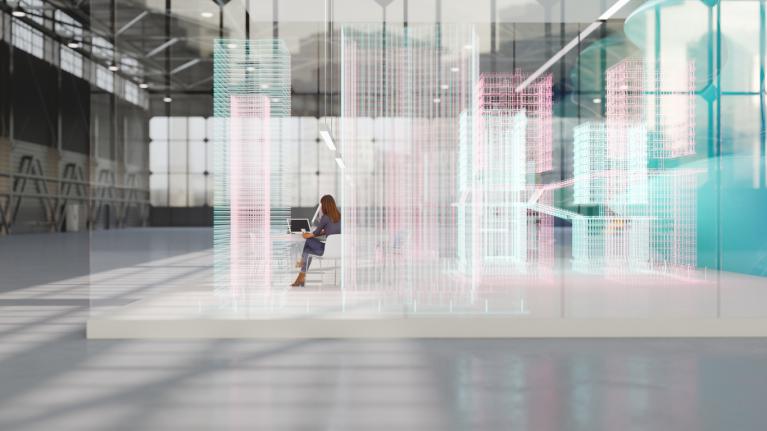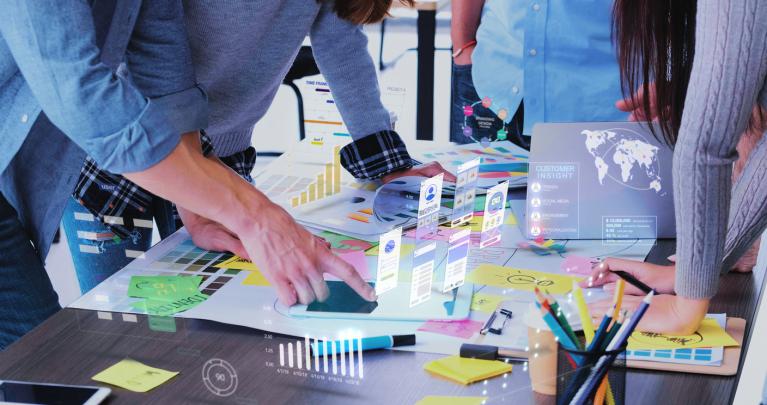It would seem that the different lockdowns have accelerated
the process of digitalization in everyday life (virtual get-
togethers and games among friends, live concerts on social
media, series to watch simultaneously, etc.), but also within the
enterprises themselves. So as to become the leader in this new
universe, Facebook completely transformed the group,
recently rechristened Meta. After acquiring the Oculus VR
company, specialized in virtual reality headsets, the corporation
launched Horizon World in 2020, a multi-player social network
using the Oculus VR headset. The Meta group is now setting its
sights on the work world with the Horizon Workrooms project,
whose goal is to use the metaverse to allow colleagues to meet
up within a same space to remotely communicate and work.
Objective: to make remote meetings enchanting again by
letting participants renew links, interact in a more natural way
and gain a feeling of being present in the same space.
Of course, the Meta group will not be alone in the professional
metaverse adventure: as Apple or Alibaba are working on
similar concepts, Microsoft is also throwing its hat in the ring
by officially launching Mesh for Microsoft Teams. This mixed-
reality collaborative platform sets a foot into the future of
remote meetings with features quite similar to those of
Workrooms. These tools are as many ways “to signal that we
find ourselves in the same virtual space, that we are a team, a
group, and to contribute to diminish the level of formality and
to increase the level of engagement“, declares Jeff Teper,
Microsoft vice-president in charge of productivity tools. “We
have noted that these tools have attained both objectives, that
is, to help a team become more efficient and help individuals
to be more engaged”. Longer term, Microsoft wishes that facial
expressions be traced from those of our own faces, thanks to
the webcam. Mesh for Teams will also offer real-time translation
and transcription, thus facilitating exchanges between
colleagues the world over.
Ready to work in a 4D office?
Companies will have as well the possibility to create their own
virtual spaces in Teams. Thus, Accenture recently set up a
virtual campus for its employees that quickly became very
useful during the pandemic by offering an environment in
which employees can meet, have a cup of coffee, do
presentations, organize parties and events or welcome new
colleagues.

Therefore, one can imagine that these technologies will make
remote work easier by making it more engaging and efficient,
both in-house as with customers. Because beyond augmented
reality technologies, the Internet of Things (IoT), analysis and
predictive maintenance or real-time data visualization, these
recent technologies will allow to address many enterprise-related issues, whether in industry, mass-market distribution
or other sectors.
Let’s imagine that we may press a button and visualize the
status of the systems or that it may be possible to display on
screen the products all along the value-creation chain… Let’s
imagine that we may eliminate malfunctions even before they
happen… Thanks to the possibility of mapping out the entirety
of the product lifecycles, these scenarios have now become
reality. From design to maintenance with sales in between,
products can be digitally mapped out in their entirety. Thus, it
becomes possible to follow the whole lifecycle. In general, this
type of scenario presupposes complex, hard to use applications
and relying on a large number of distinct systems. But in the
digital age, it’s possible to simplify that, in particular thanks to
the presence of an ERP that will be even more efficient if it
interacts in a transparent manner with other software (CRM,
BI tools, …).
Infinite professional applications?
The second key factor of these scenarios is predictive
maintenance . There exist today a multitude of tools at the
service of this type de maintenance. First of all: IoT sensors
installed on the concerned equipment transmitting data
continuously. Among a plethora of information, only the
pertinent values are selected, formatted if needed and used
to obtain actionable values on the condition of a machine or
a system. These technologies allow forecasting the moment
when critical thresholds may be exceeded and cause a failure,
thus avoiding costly expenses linked to production stoppages
and repairs downstream.
Predictive maintenance thus allows to plan maintenance works
and to complete them quickly. When an issue arises – or when
an imminent failure is indicated- the repairs can be easily
performed with the help of the engineers who designed the
equipment without them be forced to travel. Equipped with
a virtual reality headset, they have available several tools for
repairs right from their offices. One can imagine, for instance,
that they might upload directly the manual or the plans of the
equipment to be repaired, stored on the ERP. On-site, the
technicians can, likewise, apply a maintenance plan, that guides
them step by step in the repair. Instructions are displayed
superimposed on top of the equipment concerned thanks to
3D modelling. Finally, if necessary, one can imagine that the
spare part may be ordered directly by activating the process
within the ERP, straight from their headset.
To work together on the same project as if everyone was in the
same room, dive into 3D plans, read instructions in
superimposition as they are being implemented, do repairs
remotely, train collaborators by putting them in a real situation,
improve know-how, redraw the way the consulting business is
carried out… one can presciently feel it, the alternative-reality
universes integrated into the ERP of the future are not done
surprising us.

To work in project mode
Let’s imagine the prototype of a vehicle. A VR headset on, each participant may examine the prototype under all of its angles. A project leader may annotate the model with a stylus, write an explanation on an interactive whiteboard or even immerse a tool as if they were inside the vehicle. When designing the vehicle, the different units of the company will thus be able to work remotely together in a fluid and hyper efficient manner.
Did you say metaverse?
The metaverse (or métavers in French) designates an immersive experience in a virtual three dimensional environment where it’s possible to move around through an avatar or a hologram. “The metaverse is an embodied Internet where you are inside of the experience, and not only looking at it”, explains Mark Zuckerberg. In this alternative reality, it is possible for several individuals to play but also to discuss and work by participating in a common meeting or project. The metaverse uses the augmented-reality (AR) technologies as well as those of virtual reality (VR) to create a collective and participative universe in which one finds the entirety of the verbal and non-verbal communication rules of the real world: gestures, facial expressions and tone of voice.
Sources: siecledigital.fr, blogdumoderateur.com, blog-cosmo-consult-France, usinenouvelle.com







